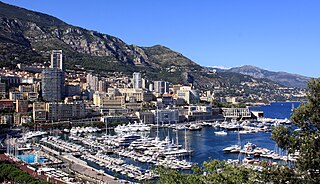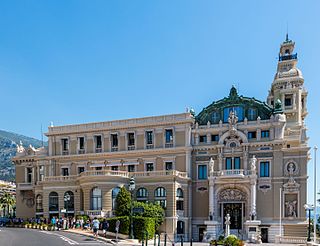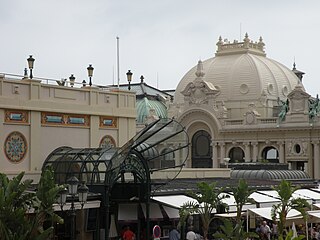
Monaco, officially the Principality of Monaco, is a sovereign city-state and microstate on the French Riviera a few kilometres west of the Italian region of Liguria, in Western Europe, on the Mediterranean Sea. It is bordered by France to the north, east and west. The principality is home to 38,682 residents, of whom 9,486 are Monégasque nationals; it is widely recognised as one of the most expensive and wealthiest places in the world. The official language of the principality is French. In addition, Monégasque, Italian and English are spoken and understood by many residents.

Monte Carlo is officially an administrative area of the Principality of Monaco, specifically the ward of Monte Carlo/Spélugues, where the Monte Carlo Casino is located. Informally, the name also refers to a larger district, the Monte Carlo Quarter, which besides Monte Carlo/Spélugues also includes the wards of La Rousse/Saint Roman, Larvotto/Bas Moulins and Saint Michel. The permanent population of the ward of Monte Carlo is about 3,500, while that of the quarter is about 15,000. Monaco has four traditional quarters. From west to east they are: Fontvieille, Monaco-Ville, La Condamine, and Monte Carlo.

Prince Pierre of Monaco, Duke of Valentinois was the father of Rainier III of Monaco. He was a promoter of art, music, and literature in Monaco and served as the head of the country's delegation to the United Nations Educational, Scientific, and Cultural Organization (UNESCO) and to the International Olympic Committee.

The Opéra de Monte-Carlo is an opera house which is part of the Monte Carlo Casino located in the Principality of Monaco.

Charles III was Prince of Monaco and Duke of Valentinois from 20 June 1856 to his death. He was the founder of the famous casino in Monte Carlo, as his title in Monegasque and Italian was Carlo III. He was born in Paris, the only son of Florestan, Prince of Monaco, and Maria Caroline Gibert de Lametz.

Marco Piccinini is a Monegasque sport personality, businessman, and politician.

The Monte Carlo Casino, officially named Casino de Monte-Carlo, is a gambling and entertainment complex located in Monaco. It includes a casino, the Opéra de Monte-Carlo, and the office of Les Ballets de Monte-Carlo.

Camille Blanc, was a French municipal leader, with many interests in Monaco. From 1904 to 1925, he was founding mayor of Beausoleil, a town adjacent to Monte Carlo, which had previously formed part of La Turbie and had been known as Monte-Carlo-Supérieur.
The Société des Bains de Mer, officially the Société Anonyme des Bains de Mer et du Cercle des Etrangers à Monaco, is a publicly traded company registered in the Principality of Monaco. SBM manages and owns the Monte Carlo Casino, the Opéra de Monte-Carlo, and the Hôtel de Paris in Monte Carlo.

The Hôtel de Paris Monte-Carlo is a hotel located in Monaco. It was opened in 1864 as part of the development of Monaco by the Société des bains de mer de Monaco. It has undergone a $280 million and more than four years complete renovation and reopened in March 2019.

The Hôtel Hermitage Monte-Carlo is a palace style Belle Époque in the heart of Monaco on the French Riviera. It belongs to the Société des bains de mer de Monaco. It was built in 1890 and 1896 the architect Nicolas Marquet with the participation of Gustave Eiffel.

The Monte-Carlo Beach is a hotel located in Roquebrune-Cap-Martin, a commune in the Alpes-Maritimes department in southeastern France. Situated on the Côte d'Azur just outside Monaco proper, the Monte-Carlo Beach hotel belongs to the Société des bains de mer de Monaco. It was built in 1929 by the architect Roger Seassal and was redesigned in 2009 by India Mahdavi.

The Monte-Carlo Bay Hotel & Resort is a resort located in the neighborhood of Larvotto, Monaco. The hotel is part of the Société des bains de mer de Monaco.

Le Mirabeau is a high-rise building in Monaco. Formerly a luxury hotel, it is now a residential building.
The Sporting d'Hiver was a historic building in Monaco. It was built in 1932 and demolished in 2015. Designed in the Beaux Arts architectural style, it was "once used to host glamorous parties and exhibitions for the world's high society".
The historical villas of Monaco represent a significant example of residential architecture. Originally seen as symbols of Belle Epoque luxury, they were once emblematic of the Principality itself. However, by the 1950s they were viewed by Monaco's Consultative Committee on Public Works as a social anachronism. While recent years have seen a renewed appreciation within the Principality for villa architecture, the number of historic villas remaining declines each year. In 1954 the Principality possessed 688 villas; only a small fraction of that number still survive.
The Monte-Carlo Sporting, also known as Sporting d'été, is a building complex in Larvotto, Monaco. It includes the Salle des Etoiles, a concert hall, and it is the main venue for society fundraisers in Monaco.

Monaco is known for its wide range of architecture for a small country. The geography of Monaco, which consists of sharp hills and narrow coastline, influences the Monacan architecture. The narrow roads have led to architectural construction being built into the hills in limited amounts of space. This limited space has, more recently, the issue of construction in Monaco has created social disruption.

Marie Charlotte Blanc was a German socialite and businesswoman. She was a prominent member of high society in Monaco and France. After the death of her husband, François Blanc, she operated the Monte Carlo Casino.

The Café de Paris is a coffeehouse and restaurant in the Belle Époque style of the 1900s, located in Monte Carlo and next to the Casino de Monte-Carlo, on the Place du Casino, facing the Hôtel de Paris. It is owned and managed by the Société des bains de mer de Monaco.















